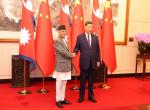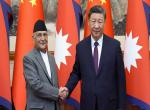The Nuclear Suppliers Group (NSG) in its June meeting has ended up by legitimizing the supply of two additional nuclear reactors to Pakistan by China. The basis of this approval is murky. The NSG guidelines do not permit members to engage in nuclear commerce with a country that has not put all its nuclear facilities, source and fissionable materials under International Atomic Energy Agency (IAEA) safeguards. In joining the cartel as a member in 2004, China accepted to abide by its restrictive rules. Pakistan, as a non-NPT country, is outside the IAEA’s full scope safeguards regime. How then to explain the China-Pakistan deal and its authorization by the NSG?
When it voluntarily joined the NSG China specified that its existing agreement to supply Chashma 1 and 2 reactors would not be covered by its new obligations. To use the procreative jargon of specialists, China “grandfathered” these two reactors. It apparently conveyed to the NSG plenary in 2004 that it had no intention to sell any more reactors to Pakistan beyond the already contracted Chashma 1 and 2, and even listed the nuclear equipment it would sell under the old 1991 agreement with its partner.
In its nuclear dealings with Pakistan, China takes tactical lessons from Russia’s nuclear power cooperation with India, and more importantly, the India-US nuclear deal and the NSG exemption accorded to India primarily at the instance of the US. Russia “grandfathered” its 1998 agreement with India to set up two nuclear power plants at Kudankulam on the ground that India and the Soviet Union had signed an inter-governmental agreement in 1988 to set up these units and Russia’s adherence to the revised NSG guidelines of 1992 embargoing nuclear cooperation with countries that do not accept full scope IAEA safeguards could not to be applied retroactively. This Russian position elicited repeated objections from the US, but Russia used the legal window available in the revised guidelines to proceed with the Kudankulam project under facility specific IAEA safeguards. China used a similar argument, as we have seen, to justify its decision to go ahead with Chashma 1 and 2.
China’s subsequent decision to disregard its NSG obligations and expand its nuclear cooperation with Pakistan by building two additional reactors has to be understood as a political riposte to the India-US nuclear deal, fed by Pakistan’s obsessive pursuit of parity with India, including in the senstive nuclear domain. Rather astutely, China has calibrated the pace of progress on the Pakistan deal keeping in view the ups and downs of the India-US pact.
In 2005, the year when PM and President Bush announced their decision to forge a nuclear pact, China and Pakistan signed an energy security agreement that envisaged substantial Chinese involvement in Pakistan’s civilian energy programme (4 more PWR reactors of 300 MW and 7 of 1000 MW capacity). This laid out the scope for their future cooperation, to be pursued depending on how the international environment for cooperation with a non-NPT country like India developed, and the openings that might get thrown up for China to assert itself in the non-proliferation domain in terms of its own interests and choices.
China was opposed to the India-US nuclear deal, characterizing it as “discriminatory” (vis a vis Pakistan, of course), although it chose not to take issue with it too frontally, preferring instead to incite other countries to resist it. The opposition within India to the deal and uncertainty created about its consummation also dictated a prudent Chinese position. China was probably deterred too from adopting a high profile position on this issue not only because of the damaging impact that would have had on the totality of India-China ties, but also because of the widely held view about its own highly dubious non-proliferation record, especially with Pakistan to whom it has furnished nuclear weapon technology and delivery systems.
In 2006 the Indo-US nuclear negotiations moved forward with President Bush signing the Congressionally approved legislation (the Hyde Act) permitting civilian nuclear cooperation with India. The same year, during President Hu Jintao’s visit to Pakistan, civilian nuclear cooperation was projected prominently as part of the agenda. However, the uncertainty created by vociferous political dissent in India on the terms of the US legislation did not politically open up space for China to move decisively forward on its parallel Pakistan deal. With the release of the text of the India-US 123 Agreement in 2007, the adoption of the India-specific safeguards agreement in August 2008 by the IAEA Board of Governors, the NSG waiver given to India in September 2008, the signing by President Bush in October 2008 of the legislation enacting the Indo-US civilian nuclear agreement and the operationalization of the 123 Agreement in the same month by both sides appending their signatures to it, cleared the political decks for China to unilaterally proceed with its plans to give parity treatment to Pakistan in the area of civilian nuclear cooperation.
In June 2008 Pakistan announced plans to build Chashma 3 and 4 with substantial credit from China. During President Zardari’s visit to China in October 2008- the same month in which the tortuous process of finalizing the India-US nuclear deal was completed- a document on civilian nuclear cooperation was signed. It was pointedly projected as a counter to the India-US deal. In March 2009, to gain lead time, the work on the design of the two additional reactors of 340MW capacity each was awarded to a Chinese company. In early 2010 Pakistan ratified an inter-governmental framework agreement with China, with the latter providing 82% of the required finance for the reactors.
In the light of these developments it became a matter of some speculation how the NSG would deal with China’s clear intention to proceed with nuclear cooperation with Pakistan notwithstanding its NSG commitments. In 2010 at the NSG meeting in New Zealand, in response to requests for clarifications from some members, China reportedly gave only vague assurances that its current and future exports would follow NSG guidelines, which is typical of the deceptive nature of its foreign policy. Reports had already begun appearing that China would justify its decision to build two new reactors on the basis that these too were part of an agreement that pre-dated its NSG membership, and hence permissible under the “grandfathering” clause. In September 2010, China unveiled its plans decisively by proposing to the IAEA that these two plants, part of a conveniently pre-dated 2003 agreement, be placed under IAEA safeguards. In March this year the IAEA unanimously approved the same type of safeguards for the new reactors as applicable to Chashma 1 and 2.
Despite the vigour of its non-proliferation rhetoric and its policy of sanctions against select countries accused of engaging in proliferation activity, the US position on China’s proliferation record has been unusually tolerant. China’s dangerous nuclear and missile proliferation activities have been primarily centered on Pakistan, deeply damaging India’s national security. The US has overlooked these activities in the past for a variety of reasons: Cold War equations, the strategic partnership with China against the Soviet Union, the unwillingness to impose sanctions on China at a time of its economic opening towards the US with all its alluring perspectives, the instrumentalization of Pakistan for countering the Soviets in Afghanistan, a better strategic balance in South Asia with the China-Pakistan nexus countering the strong India-Soviet Union/Russia relationship etc.
US has continued to underplay the China-Pakistan proliferation connection- if not actually covering it up as in A.Q.Khan’s case- even though the heaviest cost of this is borne by India. India is facing a Pakistan with an expanding nuclear and missile armoury; China has transferred plutonium processing technology to Pakistan that facilitates its development of tactical nuclear weapons; under cover of its nuclear capability which protects it from any punishing Indian retaliation, Pakistan has used the instrument of terrorism against us. At the international level, Pakistan has, with China’s support, blocked negotiations on the FMCT on the ground of an enhanced nuclear threat from India emanating from the India-US nuclear deal, without the US using any blunt instrument at its disposal to make Pakistan yield.
The reasons today for overlooking Pakistan centered proliferation activity by China are a replay of past calculations and new compulsions. China has now become far too powerful to be brow-beaten into conforming to codes of conduct established by the West; the financial and trade interdependence between China and the US at a time the US is beset by serious economic problems reduces US appetite to lock horns with China on this issue; the US needs Chinese cooperation on proliferation issues of greater concern to it than Pakistan’s case, namely, those involving Iran and North Korea; Pakistani cooperation is necessary for combating global terrorism and for managing a soft landing for the US in Afghanistan, vital politically for President Obama’s re-election; the Obama Administration, not having itself closed the door definitively to a nuclear deal with Pakistan for tactical diplomatic reasons, not only may not have wanted to aggravate Pakistan by campaigning against the Chinese deal, it may actually have seen some advantage in satisfying Pakistan indirectly vis a vis India by letting the deal go through in the NSG.
US ambiguity on the China-Pakistan nuclear deal has been evident for some time. The overall US diplomatic posture on the issue has been low-key. The US State Department has no doubt expressed the view, as recently as March this year when a senior official told reporters in Beijing that Chashma 3 and 4 cannot be grandfathered under NSG guidelines and that their supply would violate the commitments China entered into in 2004. But these have the air of pro-forma statements of limited political weight. In the opinion of some if the US had decided to make this a really contentious issue with Beijing, one involving the NSG’s future and China’s non-proliferation commitments, and had rallied key NSG members to its side, the Chinese may have resiled from going ahead. In reality, US political circles had begun conveying through leaks some time ago that they were disinclined to make an issue of this transaction in view of the need to manage the larger US stakes in the China relationship. Notwithstanding its current anti-nuclear power mood domestically, huge and growing economic stakes in China seem to have influenced the German government’s position that “China can export nuclear goods for construction of nuclear power plants Chashma 3 and 4 without violating NSG guidelines”
Many American non-proliferation diehards have deflected attention away from China’s objectionable conduct by perversely blaming the previous US Administration for violating the country’s long standing non-proliferation policies by favouring India with an unmerited nuclear deal. They have sought to place the responsibilty for China’s irresponsible behaviour towards Pakistan indirectly on India’s shoulders. In their view the US goal now should be to give an incentive to China and Pakistan to behave responsibly in the future by creating a more level nuclear playing field in South Asia between India and Pakistan. Accordingly, instead of US and China playing favourites in South Asia, a criteria based approach to civilian nuclear cooperation should be followed, as that would remove any distinction between India and Pakistan. It may be recalled that Pakistan, in seeking a nuclear deal for itself, had in fact lobbied for such a criteria-based approach for NSG waivers to non-NPT states, a position that China had supported. Having failed in that quest, the intention of anti-Indian lobbies now is to promote a criteria-based approach to NSG membership so that India’s membership, which all the major nuclear weapon states except China support, is obstructed.
The implications for India of the NSG decision white-washing the proliferation stains of the China-Pakistan deal are serious. Because China considered the India-US deal discriminatory towards Pakistan and has justified its own deal with Pakistan as a counter, the message is clear that it will promote nuclear parity between India and Pakistan and neutralize any political or strategic advantage India may gain over Pakistan by way of international acceptance of the legitimacy of its nuclear programme outside the NPT. If, as some believe, China sees the India-US deal as part of the strategic alignment of the two countries against it and has reacted by strengthening its strategic links with Pakistan, the anti-Indian thrust of China’s decision becomes even more clear. China’s nuclear power play in our region has thus succeeded at India’s expense. What is particularly unfortunate is that China, the US and others have allowed this transaction despite many unanswered questions about Pakistan’s state supported clandestine proliferation activities, and more objectionably, at a time when Pakistan’s internal stability is under threat from rising religious extremism and terrorism, raising fears about the security of its nuclear weapons, especially in the wake of reports about Islamic elements having penetrated its armed forces which control the country’s nuclear arsenal.
If China, Pakistan and non-proliferation lobbies in the US have rallied against the so-called discriminatory treatment of Pakistan vis a vis India in nuclear matters, the upshot of the NSG approval reverses the situation. India could not obtain international civilian nuclear cooperation after Kudankulam 1 and 2 despite approaches to Russia and France, both of whom cited their international obligations as an obstacle. India obtained gratification on this score eventually, but after the issue was intensely debated by political parties, legislators and opinion makers both in US and India, an arduous legislative process was undergone, restrictive non-proliferation and even political conditions were imposed on India requiring it to separate its military and civilian facilities, observe a moratorium on testing and accept sanctions by way of the “right to return” should it default, cooperate in negotiating the FMCT, set up a special reprocessing facility to US standards for fuel from the internationally assisted reactors, negotiate an India-specific safeguards agreement with the IAEA and formally reiterate its already agreed non-proliferation commitments for the satisfaction of the NSG members before receiving the waiver etc. After Chashma 1 and 2 Pakistan has obtained access to foreign collaboration without debate, without a legislative process, without separation, without any of the galling non-proliferation conditions imposed on India.
Regrettably, we have ourselves contributed to this outcome by adopting a largely unconcerned posture on the issue publicly. We have consciously downplayed its contentious aspect in our relations with China. In the IAEA, for technical reasons, India did not raise any objection to the proposed reactors being placed under safeguards. If, in consideration of our interests and the overall development of our ties with China, we chose to be prudent about raising the profile of this issue in our bilateral or multilateral diplomacy, and if we did not want to disturb the rthym and atmosphere of our dialogue with Pakistan by diplomatically opposing the China-Pakistan deal and provoking a Pakistani reaction, our own responsibility for the facility with which the NSG took the decision should not be overlooked. While the US and others have their own responsibility in preserving the sanctity of the NSG rules and we could have assumed opposition from them to the China-Pakistan deal, we could not legitimately expect them to more mindful of the anti-Indian motivations of this deal, and the nuclear nexus between an inveterately hostile Pakistan and a power ambitious China, than we ourselves. We could not have stopped this deal, but we could have expressed our concerns more visibly.
The June NSG meeting has added to our discomfiture by its as yet unpublished decision to “strengthen its guidelines on the transfer of sensitive enrichment and reprocessing technologies” by adding objective criteria that would require recipient countries to be “in full compliance” with the NPT, adhere to IAEA safeguard provisions and allow more extensive monitoring of their nuclear facilities under the terms of an Additional Protocol. India was counting on the resistance within the NSG by some countries to any agreement on such provisions for safeguarding its “clean waiver”, but the concerns of these countries seem to have been accommodated in the revised guidelines, and left India exposed.
The issue of a “clean waiver” from the NSG is politically sensitive in India, as the government claims such a waiver has been accorded, but critics dispute such an interpretation. In the negotiations leading up the nuclear deal, India had wanted and secured language in the 123 agreement and the NSG waiver that did not specifically prohibit transfer of ENR (enrichment and reprocessing) technologies to India. This was considered important to demonstrate that India had not compromised its key national interests in securing the nuclear deal, and that all relevant technologies for peaceful nuclear purposes would be available to India. Even though India possesses its own ENR technologies, this was considered an issue of principle.
The non-proliferation lobby in the US has been advocating denial of these technologies to India as a non-NPT country. Their objective is to roll back the so-called clean waiver given earlier to India through the revised guidelines. In the light of the Indian sensitivities and in order not to vitiate the atmosphere at a time when the fruits of the nuclear deal are yet to be culled in terms of concrete contracts, the US State Department has issued a statement that the Obama Adminstration fully supports the clean NSG exception for India and that “nothing about the new Enrichment and reprocessing (ENR) transfer restrictions agreed to by NSG members should be construed as detracting from the unique impact and importance of the US-India agreement and our commitment to full civil nuclear cooperation”. This is carefully hedged language as “full civil nuclear cooperation” has not been defined anywhere. Moreover, nowhere in the agreements already reached is there a specific legal commitment to provide ENR technologies. These sensitive aspects of the nuclear deal were left deliberately vague by both parties so that each side could interpret the language as it suited it. The Russian spokesman has evaded answering the question whether the revised guidelines apply to India, whereas the French side has used congenial language like the US, but which avoids taking any definitive position and leaving the issue to pan itself out in the future.
The September 2008 NSG exception for India removed the IAEA full scope safeguards requirement for India. Do the revised guidelines exempt India from the new restrictions? It is illuminating that the June 23 US State Department press release said that “efforts in the NSG to strengthen controls on the transfer of ENR are consistent with long-standing US policy that pre-dates the Civil Nuclear Agreement and have been reafirmed on an annual basis by the (G8) for years”. According to a US official quoted by the US Arms Control Association, the 2008 NSG decision exempts India only from the section of the guidelines dealing with full-scope safeguards and specifically says that “transfers of sensitive exports remain subject to paragraphs 6 and 7”. The underlying concern is that ENR technologies cannot be safeguarded against use for military purposes and that India could use access to these sensitive technologies for its unsafeguarded military programme. The nuance in the US/European position on abiding by commitments to “full civilian nuclear cooperation” with India should not be missed. ENR technologies fall in the dual use category, and because they have a clear military use they do not strictly fall within the “civilian technology” category. So, when “full civilian nuclear cooperation” is promised, it does not necessarily include ENR technologies.
Dr Kakodkar, the former DAE Chairman and one of the main architects of the nuclear deal, recognizes that the the additional NSG restrictions on transfer of ENR technologies has caused “huge unease” in India, negating the “positive and forward-looking orientation with respect to ENR issues built into our bilateral and multilateral agreements” on civil nuclear cooperation, “circumscribing” the NSG waiver and appearing “to shut doors on commerce related to ENR technologies”. He believes the latest decision essentially targets India, and suspects that statements by US and others about adhering to understandings with India could be “doublespeak”, as these statements are far from being explicit on ENR transfers. He goes on to persuasively argue that India should have sustained access to international commerce for facilities that we place under IAEA safeguards. India would be setting up reprocessing plants to reprocess used fuel from safeguarded reactors and enrichment plants for producing fuel for our imported reactors, and such reactors should not be denied access to international commerce. There is also the question, as he points out, of supply of non-ENR related equipment to enrichment and reprocessing plants in India set up under safeguards, which if affected could create its own complexities for establishing proper safeguard dispositions at the technical level.
The NSG took no decision on India’s membership for which President Obama promised support during his November 2010 visit to India, merely stating that the subject was discussed. No early decision is thus in the offing, whereas India has bound itself to observe all fresh guidelines agreed to by the Group.
Our Foreign Office has cautioned against any over-reaction to the latest NSG decision, stating that the last word has not been said, and hinting that India would use its clout to obtain satisfaction from its nuclear partners. It is not clear whether we did any muscle-flexing with them before the NSG. If we did, our warnings have obviously gone unheeded. If we did not, then ex post facto bravado is not guaranteed to produce results. While hints of uncharacteristic pugnacity are not unwelcome in themselves, our record in dealing with the China-Pakistan nuclear deal and the compromises we accepted in concluding the nuclear deal with the US raise doubts about our capacity to play hard ball in a sustained manner.
--------------------------------------------------------
Published in FORCE Magazine August - 2011








Post new comment